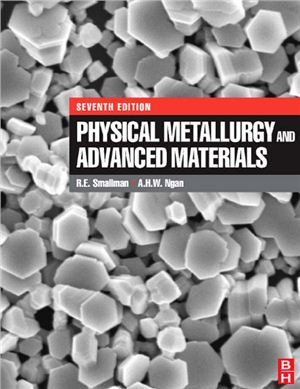Physical Metallurgy andAdvanced Materials(Seventh edition
2007,Published by Elsevier Ltd). Language: English, 673 pages.
The book has evolved from the earlier editions of Mode PhysicalMetallurgy (1962, 1970, 1985) and later editions of Mode Physical Metallurgy and Materials Engineering (1995, 1999). Additions have been made to almost every chapter, which now include a number of worked examples in the text to illustrate and emphasize a particular aspect of the subject. At the end of each chapter there is a set of questions to emphasize important material properties, e.g. elastic moduli, atomic dimensions, etc.
The early chapters are predominantly directed towards metals (physical metallurgy) but the principles are equally relevant to non-metals, which are specifically dealt with in the later chapters. Characterization using X-rays, electron microscopy, etc. is important to all areas of materials and several newtechniques such as scanning tunneling microscopy (STM), atomic force microscopy (AFM), nanoindentation and so on have been described. The book ends with a focus on some newer areas which are developing rapidly and are being incorporated to a greater or lesser extent in a number of university courses. The presentation of biomaterials, sports materials and nanomaterials is very much illustrative of the essential and significant application of a wide variety of materials and associated materials science to the successful development of these new fields.
The book has evolved from the earlier editions of Mode PhysicalMetallurgy (1962, 1970, 1985) and later editions of Mode Physical Metallurgy and Materials Engineering (1995, 1999). Additions have been made to almost every chapter, which now include a number of worked examples in the text to illustrate and emphasize a particular aspect of the subject. At the end of each chapter there is a set of questions to emphasize important material properties, e.g. elastic moduli, atomic dimensions, etc.
The early chapters are predominantly directed towards metals (physical metallurgy) but the principles are equally relevant to non-metals, which are specifically dealt with in the later chapters. Characterization using X-rays, electron microscopy, etc. is important to all areas of materials and several newtechniques such as scanning tunneling microscopy (STM), atomic force microscopy (AFM), nanoindentation and so on have been described. The book ends with a focus on some newer areas which are developing rapidly and are being incorporated to a greater or lesser extent in a number of university courses. The presentation of biomaterials, sports materials and nanomaterials is very much illustrative of the essential and significant application of a wide variety of materials and associated materials science to the successful development of these new fields.

